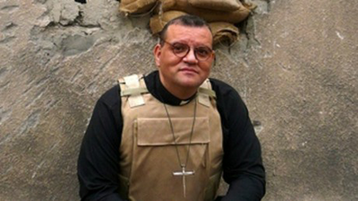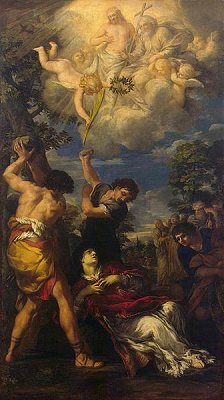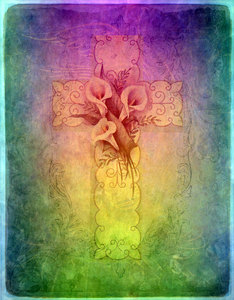 Andrew White, Vicar, ST George's Anglican Church, Baghdad, Iraq
Andrew White, Vicar, ST George's Anglican Church, Baghdad, Iraq The Edge Of Extinction, by Mindy Belz, World Magazine
"Sunday morning dawns bright, glaring bright, at St. George’s Church in Baghdad. In April daytime temperatures regularly climb to 100 degrees, but mornings and evenings are on the cool side, the air breezy and soft. Outside the church a rose garden is in full bloom—red, coral, yellow, white, and pink blossoms massed in border shrubs. Along one side of the garden is nothing but hedge, a thick, high wall of green giving a little shade and relief in the late afternoon. You have to stand close to see that the hedge is hiding a blast wall—concrete about 6 inches thick and 12 feet high runs the perimeter of the church property.
"The front steps of St. George’s used to open onto a two-lane street with steady but subdued traffic in an area of government buildings. Anyone was welcome to enjoy the garden. That all changed when suicide bombers and insurgent fighters began targeting St. George’s and other churches in Baghdad shortly after the 2003 U.S.-led invasion.
"In 2005 five members of the church leadership disappeared—all presumed killed returning by car across the desert from a pastors’ meeting in Amman, Jordan. Bombings and rocket launches by terrorists multiplied—in 2005, 2007, and notably in 2009, when a bomb detonated near the church killed 100, injured hundreds more, and damaged every building on the property. To survive, St. George’s today sits surrounded by the concrete blast walls, and two checkpoints manned by a swarm of Iraqi soldiers have to be navigated before arriving at a fortified gate that can only be opened from the inside.
"When U.S. troops made their final withdrawal from Iraq in 2011, many Americans thought the war had ended. But for most Iraqis, the terror that began with the U.S. arrival in 2003 has never stopped. Civilian deaths, in fact, currently are running at their highest level since the height of the U.S.-led war. The UN reported 8,868 casualties from insurgent-led attacks in 2013, the highest death toll since 2008. Sadly, the 2014 toll is keeping pace, with over 2,200 deaths reported in the first three months of the year.
"The run-up to Iraq’s first national election following the U.S. withdrawal, scheduled for April 30, coincided with new aggression from foreign fighters spilling from neighboring Syria. The Islamic State of Iraq and the Levant (ISIL), the new brand of al-Qaeda in Iraq, took over the city of Fallujah in January, and by April was making gains against Iraqi forces in Ramadi, just 80 miles from Baghdad. Overall, disgruntled Sunni militants are determined to undermine the Shiite-led government of Prime Minister Nouri al-Maliki.
"‘You are my people, in my beloved Iraq, and I am so glad to be back with you.’—Canon Andrew White
"Christians continue to be targets. Three bombs on Christmas Day 2013 targeted Christian neighborhoods and a church in Baghdad, killing 37 and wounding 59. This year a car bomb near St. George’s in February killed two close associates of the church, shopkeepers who helped with supplies. Also that month, a car bombing along a main thoroughfare in central Baghdad’s Karada district killed a man who had attended the church, along with three others.
“'We are all in such a desperate situation and all we have is our Lord and each other,” said Canon Andrew White, the British clergyman at St. George’s who improbably has come to be known as “the vicar of Baghdad...'”


 RSS Feed
RSS Feed